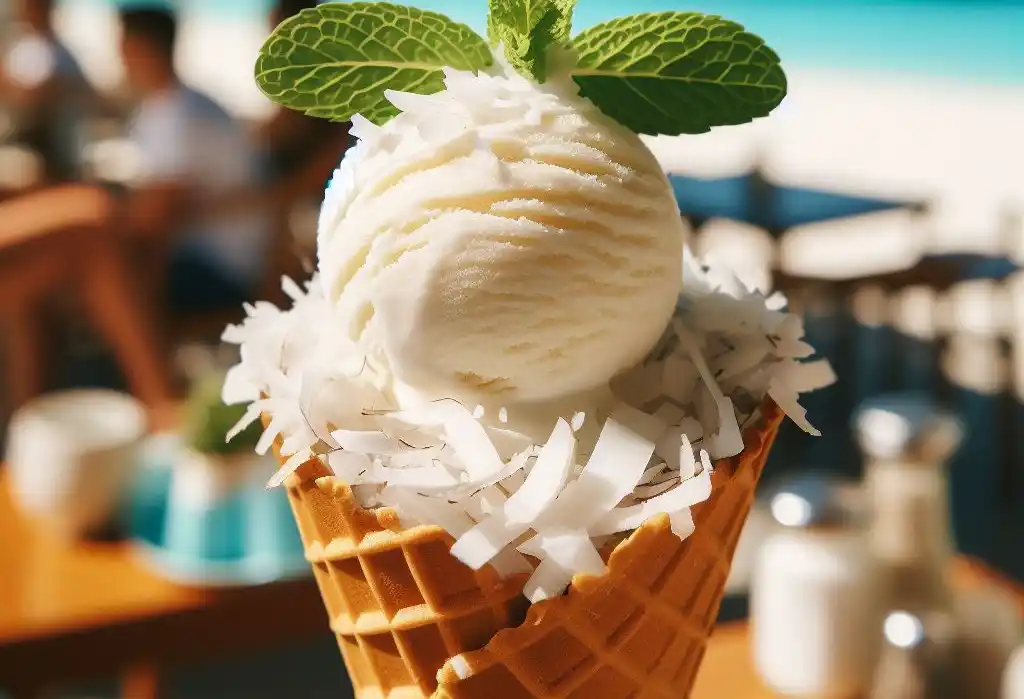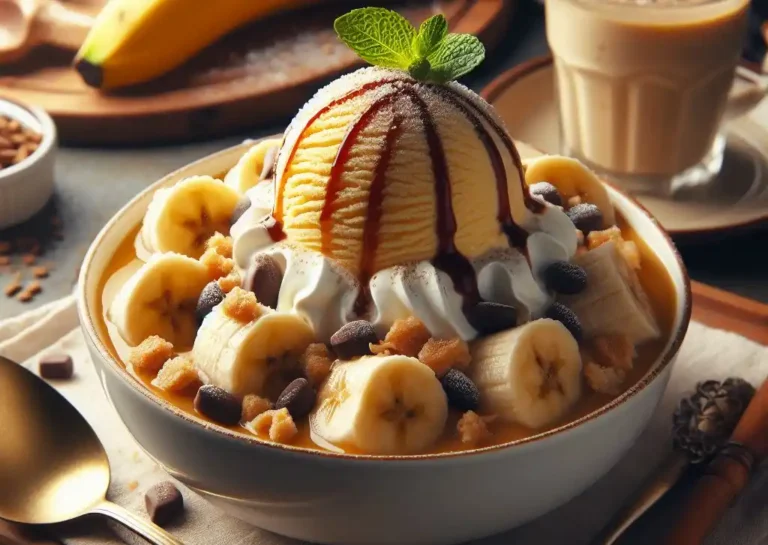Coconut Ice Cream Recipe: A Step-by-Step Guide to Creamy Perfection
If you’re a fan of creamy, delicious desserts, then homemade Coconut Ice Cream is a must-try treat.
This tropical twist on traditional ice cream is not only incredibly flavorful but also dairy-free, making it a great option for those with dietary restrictions.
In this ultimate guide, we’ll walk you through everything you need to know to make your own Coconut Ice Cream at home.
Coconut Ice Cream Recipe – A Quick Overview

Delving into the art of making Coconut Ice Cream at home can be an exciting adventure. This quick overview gives you a snapshot of what to expect in the process:
Recipe Description: A smooth, creamy ice cream made with coconut milk and infused with the tropical essence of coconut. Perfect for a dairy-free indulgence.
Preparation Time: 15 minutes
Cooking Time: 0 minutes (Freeze time approximately 4-6 hours)
Total Time: About 4-6 hours, depending on freeze time
Type of Dish: Dessert
Cuisine of the Recipe: Inspired by tropical cuisines but widely enjoyed globally
Quantity Produced by the Recipe: Serves 4-6
The Number of Calories in the Recipe: Approximately 300-400 calories per serving (varies based on ingredients used)
Origin And History Of Coconut Ice Cream Recipe

The origins of Coconut Ice Cream trace back to tropical regions where coconuts naturally thrive, primarily in Southeast Asia and parts of Latin America.
It emerged as a popular treat when locals began combining the readily available coconut milk with ice to create a refreshing dessert.
Over time, this simple concoction evolved into the more sophisticated coconut ice cream we enjoy today, incorporating various ingredients to enhance its flavor and texture.
As travel and trade introduced coconuts to different cultures, the love for Coconut Ice Cream spread globally, becoming a beloved dessert in many countries.
Why Coconut Ice Cream is a Must-Try Treat?

- Unique Flavor Profile: Coconut Ice Cream stands out with its distinct tropical flavor. The creamy texture combined with the natural sweetness of coconut offers a refreshing taste that’s hard to find in other ice cream varieties.
- Dairy-Free Delight: For those who are lactose intolerant or simply choosing to avoid dairy, Coconut Ice Cream presents a perfect alternative. Made with coconut milk, it’s a delightful way to enjoy creamy desserts without the dairy.
- Healthier Option: Compared to traditional ice cream, Coconut Ice Cream can be a healthier choice. Coconut milk contains beneficial fats known as medium-chain triglycerides (MCTs), contributing to its nutritional profile.
- Versatile Dessert: This ice cream pairs wonderfully with a wide range of toppings and mix-ins, from tropical fruits like pineapple and mango to nuts and chocolate. Its versatility makes it a hit at any gathering.
- Easy to Make: With a simple list of ingredients and no need for complicated techniques, making Coconut Ice Cream at home is surprisingly easy. It’s a fun kitchen project with delicious results.
- Escape to the Tropics: Every spoonful of Coconut Ice Cream is like a mini-vacation to the tropics, offering an escape from the ordinary with its exotic flavors and creamy texture.
What Are The Ingredients In Coconut Ice Cream Recipe?

Creating the perfect Coconut Ice Cream at home begins with gathering the right ingredients. Here’s what you’ll need to embark on this tropical dessert adventure:
- Coconut Milk: 2 cans (13.5 ounces each) of full-fat coconut milk. This is the base that gives the ice cream its creamy texture and rich coconut flavor.
- Sweetener: 3/4 cup of granulated sugar or your preferred sweetener. Adjust according to taste. For a more natural alternative, honey or maple syrup can be used.
- Vanilla Extract: 1 teaspoon to enhance the overall flavor profile of the ice cream.
- Salt: A pinch to balance the sweetness and bring out the flavors.
- Cornstarch: 2 tablespoons (optional) to help thicken the mixture and improve the ice cream’s texture.
- Shredded Coconut: 1/2 cup (optional) for an added texture and intensified coconut taste. Remember, the beauty of making Coconut Ice Cream at home is the ability to customize.
Essential Tools For Making Coconut Ice Cream

To embark on your journey of making delicious Coconut Ice Cream at home, having the right tools is as important as having the right ingredients. Here are the essential tools you’ll need:
- Ice Cream Maker: The cornerstone of making creamy ice cream. Choose a quality ice cream maker to churn your coconut mixture into smooth, frozen perfection.
- Mixing Bowls: You’ll need a few mixing bowls for combining your ingredients. Having a set of varying sizes can be helpful.
- Measuring Cups and Spoons: Accurate measurements are key to achieving the perfect balance of flavors. Ensure you have a complete set of measuring cups and spoons.
- Whisk or Hand Mixer: For thoroughly mixing the coconut milk, sweetener, and other ingredients, a whisk or a hand mixer will do the job efficiently.
- Spatula: A spatula is essential for scraping the sides of bowls to incorporate every bit of the mixture and for transferring the ice cream to a storage container.
- Freezer-Safe Container: After churning, you’ll need an airtight, freezer-safe container to freeze the Coconut Ice Cream until it reaches the desired consistency.
- Ice Cream Scoop: For serving your homemade Coconut Ice Cream, a sturdy ice cream scoop will create those perfect, appetizing scoops. With these tools at your disposal, making homemade Coconut Ice Cream will be an enjoyable and rewarding experience.
Step-by-Step Guide to Making Coconut Ice Cream

Preparing the Coconut Milk Mixture
- Chill the Coconut Milk: Ensure your cans of full-fat coconut milk are well-chilled by placing them in the refrigerator at least a few hours before starting, preferably overnight. This helps in separating the cream from the liquid.
- Mix Ingredients: In a large mixing bowl, whisk together the chilled coconut milk, sweetener, vanilla extract, and a pinch of salt until the sugar is fully dissolved. If you’re using cornstarch, mix it with a small amount of the coconut milk to create a slurry before adding it to the rest of the mixture.
Churning the Ice Cream
- Prep Your Ice Cream Maker: Make sure the bowl of your ice cream maker is fully frozen. Follow the manufacturer’s instructions for prepping your machine.
- Pour and Churn: Pour the coconut milk mixture into the ice cream maker and churn according to the manufacturer’s directions. This usually takes about 20-25 minutes.
- Transfer to Container: Once the ice cream has thickened and has a soft-serve texture, transfer it to a freezer-safe container. Mix in shredded coconut if desired at this stage for added texture.
- Freeze to Harden: Cover the container and freeze the ice cream for at least 4-6 hours, or until it is firm.
- Thaw Before Scooping: Let the ice cream sit at room temperature for a few minutes before scooping to make serving easier.
Customizing Your Coconut Ice Cream

Customizing your Coconut Ice Cream allows you to tap into your creativity and tailor this delightful treat to your personal taste preferences. Here are some ideas to get you started:
- Fruit Infusions: Add pureed or diced tropical fruits such as mango, pineapple, or passion fruit into the mix before churning. The vibrant flavors will enhance the tropical essence of the coconut.
- Chocolate Twist: For a decadent twist, fold in chocolate chips or a swirl of melted chocolate after churning. Dark chocolate pairs particularly well with the creamy coconut base.
- Nutty Addition: Stir in chopped nuts like almonds, cashews, or macadamia nuts for a crunchy texture and a nutty flavor that complements the coconut.
- Exotic Spices: Infuse the coconut milk mixture with spices such as cinnamon, nutmeg, or cardamom during the initial mixing stage. These warm spices add depth and complexity to the ice cream.
- Herbal Notes: Fresh herbs like mint or basil can offer a refreshing contrast to the sweetness of the ice cream. Finely chop the herbs and mix them in just before churning.
- Swirls and Ribbons: Create visually appealing and flavorful swirls by gently folding in fruit compotes, caramel, or coconut caramel right before transferring the ice cream to the freezer-safe container.
Common Mistakes To Avoid

- Not Using Full-Fat Coconut Milk: Opting for light coconut milk will result in a less creamy texture. Always use full-fat coconut milk for the richest flavor and texture.
- Insufficient Chilling of Coconut Milk: Failing to chill the coconut milk thoroughly can prevent the mixture from thickening properly during churning. Make sure it’s well-chilled for the best results.
- Overloading with Sweetener: While it might be tempting to add extra sweetener, doing so can overpower the delicate coconut flavor. Stick to the recommended amount or adjust slightly to taste.
- Skipping the Ice Cream Maker Pre-Chill: The bowl of your ice cream maker should be completely frozen before use. Not pre-chilling it can result in a soupy mixture rather than ice cream.
- Rushing the Freezing Process: Patience is key. Rushing the ice cream out of the freezer too soon will give you a slushy consistency. Give it ample time to firm up properly.
- Not Letting it Thaw Slightly Before Serving: If you serve the ice cream straight from the freezer, it may be too hard to scoop. Letting it sit for a few minutes at room temperature can make scooping easier and enhance the flavor experience.
What Are the Best Ways to Serve Coconut Ice Cream?

- Accompanied by Tropical Fruits: Enhance the tropical vibe by serving your Coconut Ice Cream with a side of fresh, diced tropical fruits such as mango, pineapple, or papaya. This not only adds a burst of color but also complements the coconut flavor perfectly.
- With Warm Desserts: Pair it with warm desserts like lava cakes or brownies. The contrast between the cool, creamy ice cream and the warmth of the dessert makes for an irresistible combination.
- As an Ice Cream Sundae: Elevate your Coconut Ice Cream by transforming it into a sundae. Layer it with sliced bananas, a drizzle of warm chocolate or caramel sauce, and a sprinkle of toasted coconut flakes or nuts for a delightful crunch.
- In a Coconut Shell: For a stunning presentation, serve the ice cream in a hollowed-out coconut shell. This not only makes for a beautiful serving vessel but also intensifies the coconut experience.
- As a Float: Create a tropical-inspired float by adding a scoop of Coconut Ice Cream to a glass of chilled pineapple or mango juice. This refreshing treat is perfect for hot summer days.
- With Coffee or Espresso: For a more adult twist, serve a scoop of Coconut Ice Cream with a shot of hot espresso poured over it. The coffee’s richness brings out the ice cream’s creamy texture and coconut flavor in a delightful way.
Tips For Preserving Freshness and Flavor for Longer
- Airtight Storage: Utilize an airtight container for storing your Coconut Ice Cream. This minimizes exposure to air, which can cause ice crystals to form, affecting texture and flavor.
- Press Plastic Wrap: Before sealing the container, press a sheet of plastic wrap directly onto the surface of the ice cream. This extra barrier helps prevent ice crystals and keeps the ice cream moist.
- Keep It Deep: Store your ice cream deep in the freezer, away from the door. Frequent temperature changes from opening the door can cause the ice cream to soften and refreeze, leading to texture changes.
- Short-term Enjoyment: While it’s tempting to keep homemade ice cream for a long time, it’s best enjoyed within a week or two. Over time, even in optimal conditions, flavor and texture may degrade.
- Revive with a Blender: If your ice cream does become a bit icy, consider giving it a quick blend in a high-speed blender or food processor. This can help restore a creamier texture, though it’s best done immediately before serving.
How to Make This Recipe Perfect Every Time?
- Pay Attention to Ingredient Quality: Use high-quality, full-fat coconut milk for the creamiest texture. The better the coconut milk, the richer and more flavorful your ice cream will be.
- Experiment with Sweeteners: Different sweeteners can alter the taste and texture of your ice cream. Experiment with granulated sugar, honey, or maple syrup to find what works best for you.
- Temperature Matters: Ensure all ingredients, especially the coconut milk, are cold before starting. This helps in achieving a smoother consistency during the churning process.
- Churn to Perfection: Follow your ice cream maker’s instructions closely. Over or under-churning can affect the ice cream’s texture.
- Customize with Care: If adding mix-ins like fruits, nuts, or chocolate, do so at the correct time—usually near the end of churning. This ensures even distribution without affecting the ice cream’s base structure.
- Freeze Promptly and Properly: Transfer your ice cream to a freezer-safe container as soon as churning is complete. A quick transition from churner to freezer helps prevent ice crystals from forming.
- Thaw with Patience: Give your ice cream a few minutes at room temperature before serving. This slight thawing makes scooping easier and enhances the flavors.
Conclusion
Embarking on the journey to create homemade Coconut Ice Cream is an adventure in flavor and culinary creativity.
From understanding its tropical origins to customizing your batch with unique mix-ins, this guide has equipped you with the knowledge to craft a dessert that’s as delightful to make as it is to eat.
Whether you’re seeking a dairy-free alternative or simply yearning for a taste of the tropics, making Coconut Ice Cream at home offers a satisfyingly sweet escape. Now, it’s your turn to churn up some magic and enjoy the creamy, coconutty goodness in every scoop.
FAQs
Can I make Coconut Ice Cream without an ice cream maker?
Yes, it’s possible. After mixing your ingredients, place the mixture in a freezer-safe bowl and freeze. Every 30 minutes, stir vigorously to break up ice crystals, repeating this process for 2-4 hours until the consistency is similar to that of churned ice cream.
Is there a vegan sweetener alternative?
Absolutely! Agave syrup, coconut sugar, and maple syrup are great vegan options that complement the coconut flavor well. Adjust sweetness to taste.
How long can I store homemade Coconut Ice Cream?
For the best quality, enjoy your Coconut Ice Cream within 1-2 weeks. Store it in an airtight container with plastic wrap pressed onto the surface to minimize ice crystal formation.
Can I use light coconut milk? While light coconut milk can be used, it will result in a less creamy texture. For the richest flavor and texture, full-fat coconut milk is recommended.
Is it necessary to chill the coconut milk before starting?
Yes, chilling helps in separating the cream from the liquid, which is crucial for achieving the creamy texture of the ice cream. It’s best to refrigerate the coconut milk overnight.

Hello! I’m Eloise Wilson, the culinary enthusiast behind SimplyCookings. Cooking is my canvas and flavors are my palette. I’m here to share easy-to-follow recipes and kitchen wisdom that will make your cooking journey joyful and delicious. Join me and let’s turn everyday meals into extraordinary experiences!







